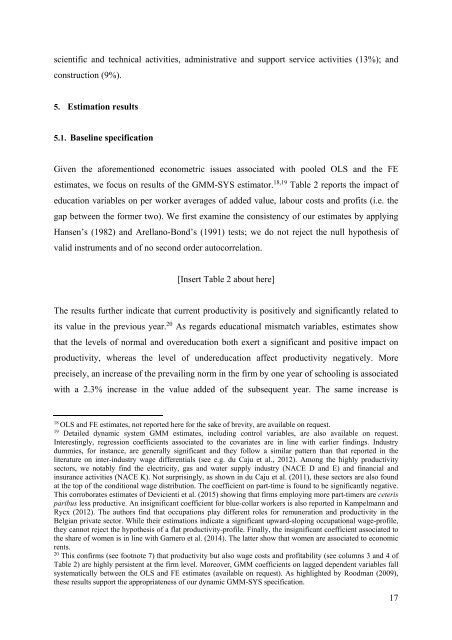CEB Working Paper
240798&r=lma
240798&r=lma
Create successful ePaper yourself
Turn your PDF publications into a flip-book with our unique Google optimized e-Paper software.
scientific and technical activities, administrative and support service activities (13%); and<br />
construction (9%).<br />
5. Estimation results<br />
5.1. Baseline specification<br />
Given the aforementioned econometric issues associated with pooled OLS and the FE<br />
estimates, we focus on results of the GMM-SYS estimator. 18,19 Table 2 reports the impact of<br />
education variables on per worker averages of added value, labour costs and profits (i.e. the<br />
gap between the former two). We first examine the consistency of our estimates by applying<br />
Hansen’s (1982) and Arellano-Bond’s (1991) tests; we do not reject the null hypothesis of<br />
valid instruments and of no second order autocorrelation.<br />
[Insert Table 2 about here]<br />
The results further indicate that current productivity is positively and significantly related to<br />
its value in the previous year. 20 As regards educational mismatch variables, estimates show<br />
that the levels of normal and overeducation both exert a significant and positive impact on<br />
productivity, whereas the level of undereducation affect productivity negatively. More<br />
precisely, an increase of the prevailing norm in the firm by one year of schooling is associated<br />
with a 2.3% increase in the value added of the subsequent year. The same increase is<br />
18<br />
OLS and FE estimates, not reported here for the sake of brevity, are available on request.<br />
19<br />
Detailed dynamic system GMM estimates, including control variables, are also available on request.<br />
Interestingly, regression coefficients associated to the covariates are in line with earlier findings. Industry<br />
dummies, for instance, are generally significant and they follow a similar pattern than that reported in the<br />
literature on inter-industry wage differentials (see e.g. du Caju et al., 2012). Among the highly productivity<br />
sectors, we notably find the electricity, gas and water supply industry (NACE D and E) and financial and<br />
insurance activities (NACE K). Not surprisingly, as shown in du Caju et al. (2011), these sectors are also found<br />
at the top of the conditional wage distribution. The coefficient on part-time is found to be significantly negative.<br />
This corroborates estimates of Devicienti et al. (2015) showing that firms employing more part-timers are ceteris<br />
paribus less productive. An insignificant coefficient for blue-collar workers is also reported in Kampelmann and<br />
Rycx (2012). The authors find that occupations play different roles for remuneration and productivity in the<br />
Belgian private sector. While their estimations indicate a significant upward-sloping occupational wage-profile,<br />
they cannot reject the hypothesis of a flat productivity-profile. Finally, the insignificant coefficient associated to<br />
the share of women is in line with Garnero et al. (2014). The latter show that women are associated to economic<br />
rents.<br />
20<br />
This confirms (see footnote 7) that productivity but also wage costs and profitability (see columns 3 and 4 of<br />
Table 2) are highly persistent at the firm level. Moreover, GMM coefficients on lagged dependent variables fall<br />
systematically between the OLS and FE estimates (available on request). As highlighted by Roodman (2009),<br />
these results support the appropriateness of our dynamic GMM-SYS specification.<br />
17


